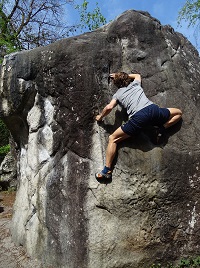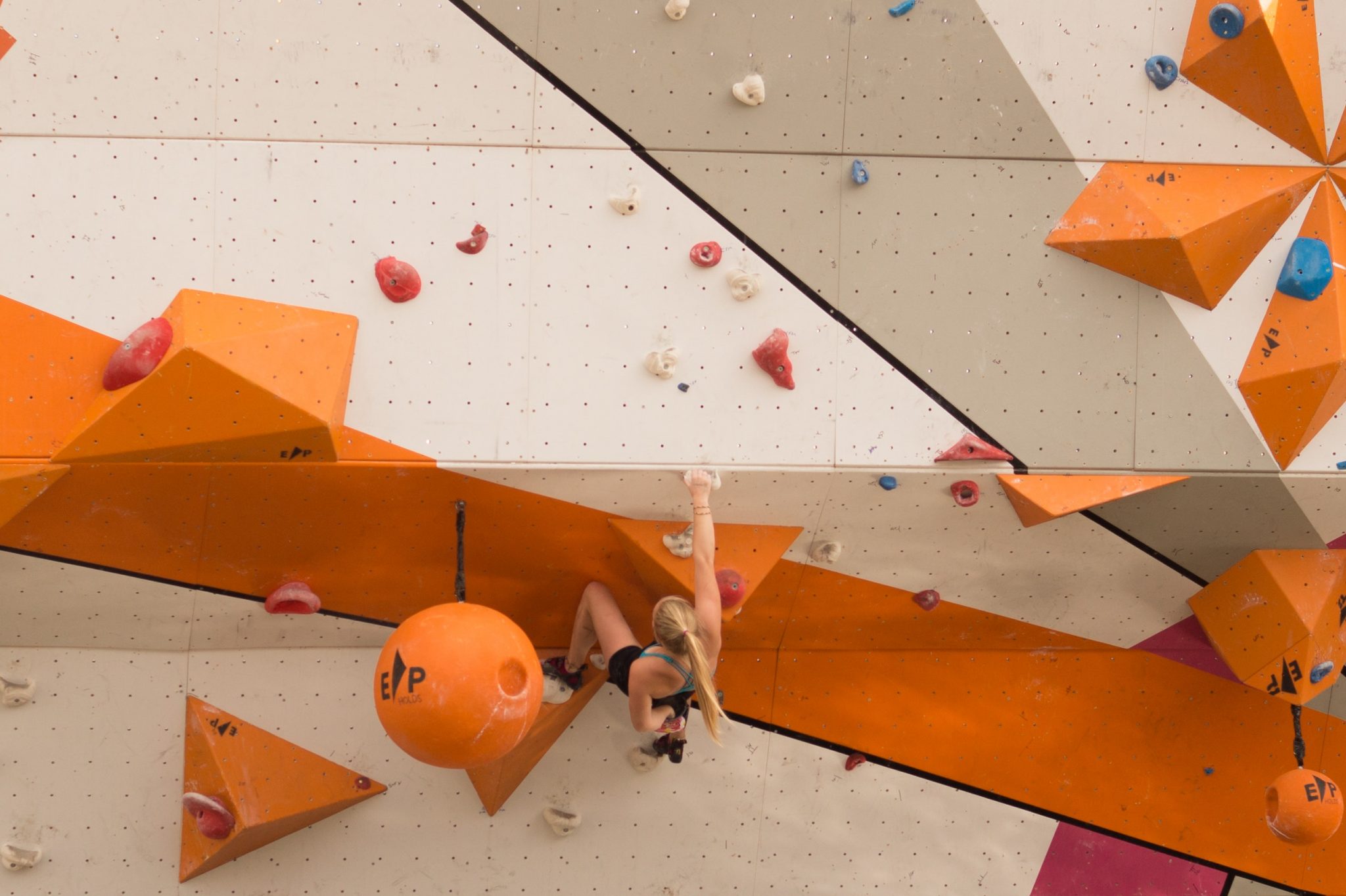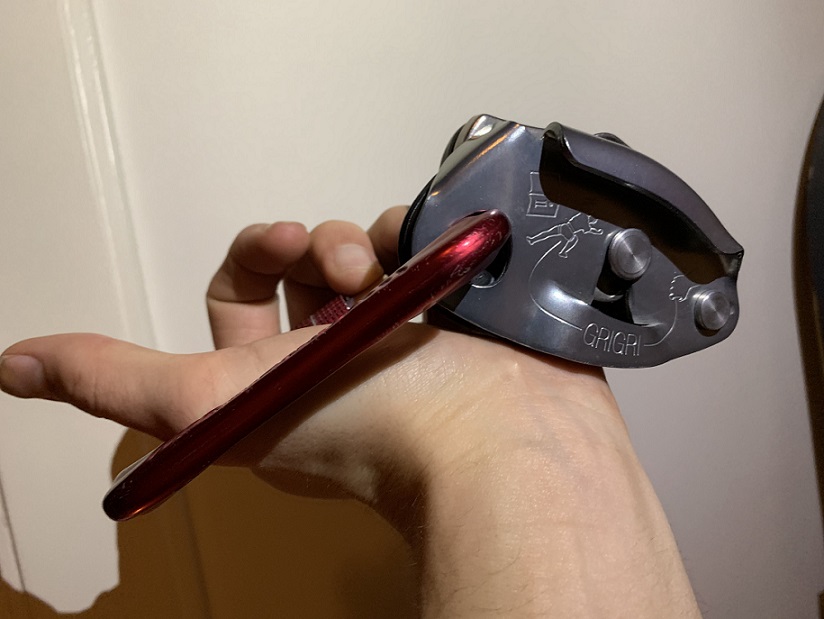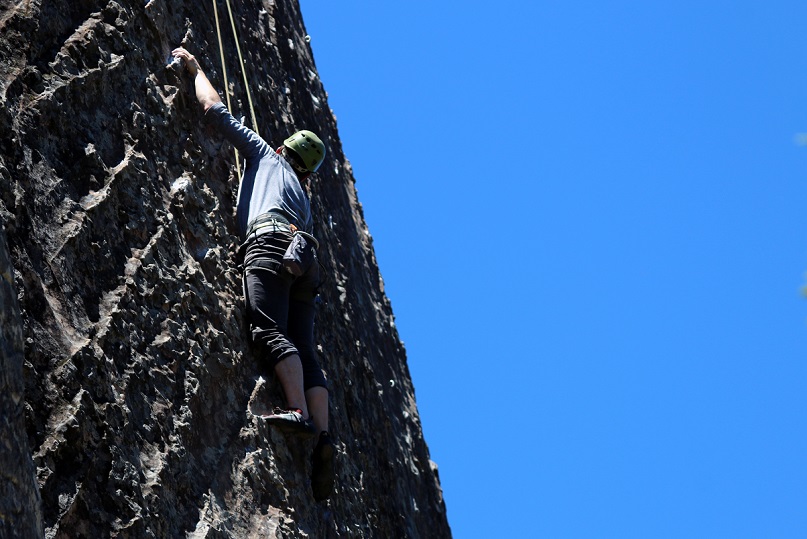Even if you’re new to climbing, you’ve probably come across the term “bouldering grades.” But if you’re still learning the basics, it can seem daunting to learn an entire bouldering grade system.
And it can seem even harder when you find out that there’s more than one grading system.
Sound confusing? Trust me—it’s not as bad as it sounds. With a solid understanding of different bouldering grades, you’ll be able to take your climbing knowledge to the next level and enjoy richer, more fulfilling climbs.
That’s why I’ve put together the following guide on bouldering grades. Here, you’ll find everything you need to know to understand these systems!
What Are Bouldering Grades?

What’s the number one priority when rock climbing and bouldering?
You guessed it—safety.
And a large part of staying safe on the rocks is understanding which climbs are at your level. For example, if you’re a beginner, you don’t want to hop on an advanced bouldering route. Doing so could place you at increased danger, as you’ll be required to have stamina and technique that you may not have yet developed. Or at least, You’ll find out that you’re wasting your time and could be training more efficiently by climbing easier routes.
To deal with this problem, climbers of generations past established a bouldering grades system. This system allows for a uniform understanding of the difficulty of different climbs, allowing boulderers to find out vital information before they commit to a climb.
That being said, it must be noted that bouldering grades differ from other types of rock climbing grades. For this reason, it’s important to have an understanding of even more systems if you plan to engage in other forms of climbing.
In this piece, let’s take a look specifically at bouldering grades—including a detailed look at the different systems available and why they’re so important to you.
Why Are Bouldering Grades Important?
Let’s start with the last question first. Why are bouldering grades so important? Shouldn’t you be able to judge the difficulty of a climb for yourself?
Perhaps sometimes—but that’s not your safest option. And it’s not the one that will allow you to get the most out of your bouldering experience.
The truth is that bouldering grades aren’t just about safety. Yes, it’s possible that you’ll overextend yourself on some challenging climbs without understanding bouldering grades. But it’s just as, if not more, likely that you’ll end up completing a few boring and uneventful climbs that are below your current skill level.
And what then? You won’t grow as a climber or feel fulfilled in your experience, as the only way to improve is to be challenged.
Because of this, understanding different bouldering grades is important if you’re looking to become the best boulderer you can be. Not only will these grades keep you safe, but they’ll give you the knowledge you need to grow and accept new challenges. As it turns out, knowledge really is power.
How Should You Use Bouldering Grades?

But putting this knowledge to good use will be the true difference in your climbs. That’s because you’ll often find that knowing bouldering grades alone isn’t enough. Instead, you’ll need to understand the context around particular climbs and situations.
For example, you may find that the rating of a certain bouldering climb is higher in one place than in another. Because the system is more or less uniform, you can expect only small differences in grades. However, these small differences can sometimes feel a lot bigger when you’re actually bouldering, so be sure to know if you’re in an area that either underrates or overrates its climbs. One of the best ways to do this is to be open and frank and talk to other climbers in the area.
climbs in the wild prove more challenging than bouldering in your local gym
What’s more, you may also find that climbs in the wild prove more challenging than bouldering in your local gym—even if they have the same bouldering grade. For this reason, make sure that you take multiple factors into account before making the final determination. And remember, to improve as a boulderer, you’ll want to choose a climb that’s both challenging, but not so far above your level so as to pose any significant threats.
What Are the Different Systems?
With this in mind, it’s time to take a look at the meat of the matter—the bouldering grades themselves. As you may have guessed, these grades aren’t quite cut and dry. In fact, with two different systems in use, you’ll have to be familiar with different styles of grading if you plan to do any bouldering while traveling internationally—depending on where you go, of course.
For example, you’ll find that Europe uses different bouldering grades than the United States, so if you’re planning on hitting up any of the famed bouldering sites in the Old World, you’ll need to do some research first.
So what are the two different bouldering systems? Let’s take a look at each in turn.
V Scale
The most widely-used bouldering ratings system in North America, the V Scale gets its name from John Sherman, a famed American boulderer who made a name for himself rating routes throughout Texas in the 1990s.
This V Scale proves relatively simple to understand, but it may take a bit of studying and practice before you’re fully familiar with the different ratings. Why? Simply because there are so many of them.
In fact, the V Scales ranges in difficulty from V0 to V17, with climbs becoming increasingly challenging the higher the grade. If that doesn’t sound complicated enough, there are some other wrinkles you’ll need to understand. But take it from me—they’re not really that hard.
For instance, over time boulderers have come to realize that rating climbs isn’t so cut and dry. What happens, for example, when a climb is harder than a typical V7 but not hard enough to be a V8? To solve this issue, “+” and “-” signs were added within different categories to show varying levels of difficulty.
Another thing to keep in mind is that you may find some charts that list VB. These routes are considered the simplest of all, easier than even V0. These basic routes are great for those who have never been on the rocks.
So what are the V Scale grades of which you should be aware? Let’s take a look!
| Beginner | Perfect for those who are just starting out and need to master the basics of climbing. | VB / V0 / V1 / V2 |
| Intermediate | Perhaps the most common climbing level, reserved for non-advanced climbers with a solid foundation of the basics. | V3 / V4 / V5 / V6 |
| Upper Intermediate / Advanced | Challenging climbs that are usually the limit for non-professional boulderers. | V7 / V8 / V9 |
| Upper Advanced / Professional | Professional-level climbing that takes years of practice and training to reach. | V10 / V11 / V12 / V13 |
| Elite | Incredibly physically taxing, requiring some of the world’s strongest and best climbers to complete. | V14 / V15 / V16 / V17 |
Fontainebleau Grades

When traveling from North America to Europe, you’re going to have to adjust your mindset. That’s because Europeans don’t typically use the same V Scale found throughout North America.
Instead, they make use of a popular grading system developed in France—Fontainebleau Grades. Like the V Scale, Fontainebleau Grades rank different climbs by their difficulty, but their lettering and numbering style differs greatly.
Whereas the V Scale ranges from VB/V0 to V17, for instance, Fontainebleau Grades range from 1A to 9A, with 9A being equivalent to V17.
Also known as the Font Scale, this grading system is open-ended just like the V Scale, meaning that additional grades can be added when more difficult climbs are discovered or created. For this reason, it’s important that you keep up with the latest grading systems to keep track of any important changes.
You’ll also notice some key differences in how the scale is used—namely in the lettering of different climbs. A great example of this is when determining what the most basic climb is. Though the scale includes lower bouldering grades, in reality, it’s extremely rare to find anything with a rating lower than a 3—or a 2B, depending on who you ask.
You may be wondering why the same climb is listed with two different levels—and the answer is simple, if still somewhat confusing. That’s because any boulderers do not add letter grades to bouldering grades before level 6—while others do.
To thicken the pot even further, it must also be noted that—just as in the V Scale—you’ll find that some climbs include a + or a – symbol. The result of this is the same. You can expect a 7A+ to be slightly more challenging than a regular 7A route, while being easier than a 7B.
Let’s take a closer look at Font Grades below.
| Beginner | Perfect for those who are just starting out and need to master the basics of climbing. | 3 / 4 / 5 / 5+ |
| Intermediate | Perhaps the most common climbing level, reserved for non-advanced climbers with a solid foundation of the basics. | 6A / 6A+ / 6B / 6B+ / 6C / 6C+ / 7A |
| Upper Intermediate/Advanced | Challenging climbs that are usually the limit for non-professional boulderers. | 7A+ / 7B / 7B+ / 7C |
| Upper Advanced/Professional | Professional-level climbing that takes years of practice and training to reach. | 7C+ / 8A / 8A+ / 8B |
| Elite | Incredibly physically taxing, requiring some of the world’s strongest and best climbers to complete. | 8B+/ 8C / 8C+ / 9A |
How Do the Grades Compare?
If you are crossing international borders in your bouldering journey, it helps to know how these two popular grading systems compare. While not the only two bouldering rating systems out there, they are by far the two most commonly used, and you’ll likely not encounter other systems even when traveling.
For that reason, let’s focus on comparing only these two widely-used grading systems.
| Level | Description | V Scale | Font Grades |
| Beginner | Perfect for those who are just starting out and need to master the basics of climbing. | VB / V0 / V1 / V2 | 3 / 4 / 5 / 5+ |
| Intermediate | Perhaps the most common climbing level, reserved for non-advanced climbers with a solid foundation of the basics. | V3 / V4 / V5 / V6 | 6A / 6A+ / 6B / 6B+ / 6C / 6C+7A |
| Upper Intermediate/Advanced | Challenging climbs that are usually the limit for non-professional boulderers. | V7 / V8 / V9 | 7A+ / 7B / 7B+ / 7C |
| Upper Advanced/Professional | Professional-level climbing that takes years of practice and training to reach. | V10 / V11 / V12 / V13 | 7C+ / 8A / 8A+ / 8B |
| Elite | Incredibly physically taxing, requiring some of the world’s strongest and best climbers to complete. | V14 / V15 / V16 / V17 | 8B+ / 8C / 8C+ / 9A |
As you may be able to tell, the different lettering options in the Font Grading system make it slightly more complicated than the V Scale. Some, however, may find that these different categories allow for more accuracy in determining climbing grades—however, do keep in mind that the V Scale tends to create a new level as opposed to lettering. Omitted here in this chart, but still occasionally used, are V Scale grades that also incorporate a +/- into the system.
What’s more, do note that, as stated, the Font Scale’s real world applications begin at level 3—and, depending on whom you ask, even sometimes level 4. For this reason, it can be said that level 3 is closer to VB—the most basic level of the V Scale. For most real world climbs, you can expect the two systems to start at V0 and level 4.
Seem like a lot to remember? Don’t worry—it’s not as bad as it may appear. And remember, you’ll have plenty of time to start getting familiar with these different bouldering grades. It will likely take you time to progress from one level to the next, so you’ll have more than enough time to get familiar with your own climbing grade and with grades of a similar level. This proves to be an efficient way of getting familiar with both grading systems, as you’ll want to steer clear of climbs that are well above your grade, for both safety and climbing reasons.
Bouldering Grades FAQ
Still have questions about bouldering grades? Don’t worry—I’ve got you covered. Check out some of the most commonly asked questions regarding this important topic!
How Do Bouldering Grades Correlate to Climber Ratings? Are They Comparable?
If you’ve already started in rock climbing and know about climbing levels, you may be wondering if these are comparable to bouldering grades. The answer, generally speaking, is yes.
However, if you do plan on comparing the two, you’ll want to make sure that you do it with the right context in mind. While it’s true that your bouldering ability may be slightly enhanced over a true beginner, consider climbing a grade or so lower than what your normal rock climbing level would suggest. If this proves to be easy, then move up. It’s better to start too easy, rather than too difficult.
Generally speaking, however, you can expect that VB correlates to around 5.1-5.8 on the YDS. Consider moving up gradually from there to ensure that you’re safely finding your bouldering level.
How Are These Grades Calculated?
Great question—because it has one of the most important answers. That is—keep in mind that grades for both the V and Font Scales refer to the physical challenges required to complete the climb. Other factors that can affect the climb are not taken into account—meaning that you’re going to have to use a bit of knowledge and context to accurately judge the safety of a particular climb.
So what other factors are there that you should consider? Your own confidence, for one. More confident climbers are able to tackle harder challenges, as they aren’t held back by fear. Nervousness, anxiety, and other factors that can influence your mood on the rocks should not be underestimated—even if it’s something as simple as being extremely hungry. Any distraction that can take your focus away from the moves necessary to complete a climb can make it more dangerous, so always be sure to factor in a multitude of different conditions when deciding if a climb is right for you.
How Do I Find My Level?
To find your bouldering level, start by practicing in the gym. If you’re a true beginner, you will likely want to start with VB or level 3 on the Font Scale. This will allow you to progress at your own pace. If you find that these levels are too easy, you can always move up without a problem.
The Bottom Line
Understanding different bouldering grades can feel daunting at first—but with a little time and practice, you’ll know them like the back of your hands.
Use these grades as general guidelines as you take to finding the right climbs for you. Remember, these are climbs that provide a challenge without unnecessary danger and fear being thrown into the mix. Used correctly, these guides are your best friends and will allow you to progress in your bouldering endeavors.
Don’t know where to start? Refer to the guide above as you find and grow your own bouldering level!






